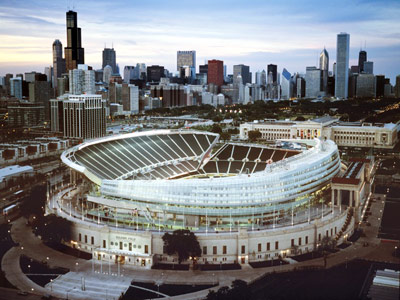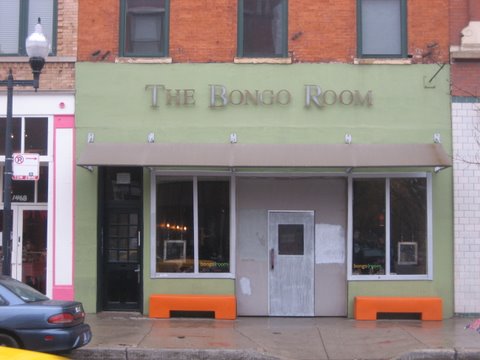I nearly fell out of my chair yesterday as I sipped on some freshly brewed coffee and took bites of a cream cheese-smothered multi-grain bagel in the cafe of a local bookstore. No, it wasn't rancid coffee that nearly caused the accident. It was the headline in the front page of the Miami Herald: "Miami looks to Chicago as its model".
My first thought was "Damn! Is Mayor Diaz reading my blog?". If so, is he preparing to raze all those buildings east of U.S. 1 within City of Miami limits in favor of our very own version of the open green space I so cheerfully discussed in previous posts, "Chicago: City Built by Flames" and "Chicago: An Architect's Playground"?
"Alright now, Mr. Diaz!" was my very next thought.
Before you grab your MH21 Grapple and start pulverizing the buildings that line our (bay)shore, let's take a closer look at the mayor's ambitious "emulation".
Let's put things in perspective. Allow me to provide you with some fun facts. After all, we make decisions and form opinions based on facts. Right?
POPULATION/DENSITY
According to a New York Times article published in 1912, census figures estimated Chicago's population to be in the neighborhood of 2,185,283 - in 1910 - just one year after Daniel Burnham's Plan of Chicago was presented to the people of Chitown.
Miami's population at that time? 5,500.
The Census Bureau estimated Miami's population to be 404,048 for 2006 (Note: figures are for the City of Miami, not the greater metro area).
Chicago's population estimate for 2006? 2,833,321.
Chicago encompasses an area of 234 square miles of which 227.2 are land and only 6.9 are water.
Miami covers an area of 55.27 square miles of which only 35.68 are land and 19.59 are water.
Chicago's population density in 2006 was estimated at 12,470 persons/square mile.
Miami's population density in 2006? 11,324 persons/square mile.
Sidebar: Miami Beach had an estimated population of 86,916 covering 7 square miles of land in 2006 for a population density of 12,416 persons/square mile.
SOCIAL CHARACTERISTICS
According to the Census Bureau's 2006 American Community Survey:
An estimated 77% (1,364,023) of Chicago's population 25 years and over (1,771,459) has at least a high school diploma. 29.3% (519,037) of those are estimated to have a Bachelor's degree or higher.
An estimated 66.1% (230,549) of Miami's population 25 years and over (348,789) has at least a high school diploma. 22.1 % (77,082) of those are estimated to have a Bachelor's degree or higher.
Approximately 36.5% (927,403) of Chicagoans speak a language other than English at home.
Approximately 76.2% (254,372) of Miamians speak a language other than English at home.
ECONOMIC CHARACTERISTICS
Median household income (known to be the best indicator of economic well-being) for Chicago in 2006 was estimated to be $43,223.
Median household income for Miami in 2006 was estimated to be $27,008.
Approximately 17.2% of families and 21.2% of all individuals in Chicago were living below the poverty level in 2006.
Approximately 22.8% of families and 26.9% of all individuals in Miami were living below the poverty level in 2006.
HOUSING CHARACTERISTICS
An estimated 49.3% of all housing units in Chicago were owner-occupied in 2006.
An estimated 36.1% of all housing units in Miami were owner-occupied in 2006.
The 2006 estimated median value of owner-occupied homes in Chicago was $277,900.
The 2006 estimated median value of owner-occupied homes in Miami was $315,900.
PUBLIC TRANSPORTATION
The Chicago Transit Authority (CTA) has approximately 2,000 buses that operate over 154 routes and 2,273 route miles that serve more than 12,000 posted bus stops and 1,190 rapid transit cars over 8 routes and 222 miles of track.
CTA offers rail service to and from both major international airports. The Blue Line takes customers to and from O'Hare International Airport. The Orange Line trains travel to Midway International Airport.
Miami-Dade Transit (MDT) has approximately 994 buses that operate over 100 routes and operates 136 Metrorail cars over 22.2 miles of elevated track, as well as 29 Metromover single units over 2.5 miles of an elevated double loop (inner & outer) in Downtown Miami.
Sidebar: I took Route 145 (Wilson/Michigan Express) from the Lake Shore/Belmont stop in the Lakeview neighborhood of Chicago into "the Loop" in Downtown Chicago (Lakeview is approximately 5 miles north of the Loop) about 3 times while I was in Chicago. The entire trip from stop to stop took approximately 15 minutes. The longest I waited at the bus stop for a bus was about 4 minutes.
The last time I attempted to leave my car at home and ride the bus in Miami I waited approximately 20 minutes at a Route 11 bus stop on W. Flagler Street on a scorching midday afternoon before deciding to walk to my destination about 1.5 miles away. The bus never passed me by.
SPORTS STADIUMS/ARENAS AS ECONOMIC DEVELOPMENT TOOLS
Contrary to what politicians or their hired consultants would have you believe regarding the economic benefits of publicly subsidized sports stadiums and arenas, the consensus amongst academic economists has been that such policies do not raise median household incomes - the best indicator of economic well-being - in the area.
Andrew Zimbalist and John Siegfried, authors of "The Economics of Sports Facilities and Their Communities", a journal entry published in the Journal of Economic Perspectives in 2000, argue that "independent work on the economic impact of stadiums and arenas has uniformly found that there is no statistically significant positive correlation between sports facility construction and economic development".
Economic "impact studies" commissioned by advocates and proponents of stadiums and arenas rarely, if ever, address the opportunity costs associated with using public funds to subsidize the construction of these buildings. The funds used to build that stadium or that arena have alternative uses. For example, instead of utilizing taxpayer money towards the construction of a stadium so that millionaire franchise owners can field a team of millionaire ballplayers, politicians can choose to use that same taxpayer money towards the betterment of highways, schools, public transportation, airports or any other number of true public investments.
It amazes me to see how willing local politicians and other leaders are to devise financing schemes and expand or restructure community redevelopment agencies to get these types of projects done, while schools continue to be unacceptably overcrowded and teachers grossly underpaid. Why can't the same types of financing schemes be devised to remedy these more important issues?
A recent measure overwhelmingly passed by voters in Seattle that requires any funds to help build a sports arena/stadium earn money at the same rate as a treasury bill (which simply means that there is no way public funds could ever be used to build an arena/stadium in Seattle), may serve as the tipping point in the other direction.
I think it's worthy to note that an estimated 91.7% of the population 25 years and over in Seattle had at least a high school diploma in 2006. An astonishing 53.4% of those are estimated to have had a Bachelor's degree or higher.
These facts may or may not be a direct correlation as to why such a measure would pass so overwhelmingly.
I'm just saying.
Disclosure: Growing up eating and breathing baseball (it feels like a lifetime ago), I enjoy catching a few Marlins games every year (especially when a local bank - that shall remain nameless - picks up the tab). If the stadium is built at the Orange Bowl site, I not only stand to benefit financially, I stand to benefit from a quality-of-life point of view. Not only will I be able to walk to the games, I can also get heavily inebriated at any one of the many bars that will surely arise as a result of the stadium's existence and not have to worry about driving home. Not that I would, but...

By the way, I can still flash some leather and turn 2 with the best of them. Que no?
Sidebar: The next time someone tells me that the reason people do not attend sporting events in Miami (unless the team fields a winner that year, of course) is because "there's just too much to do in Miami", that person finna get a roundhouse to the face. The Chicago Cubs haven't won a championship since 1908 and they sell out every home game before Spring Training has ended...and I guarantee you that there sure as hell isn't more to do in Miami than in Chicago.
Today's Chicago is best described as a city of neighborhoods - uninterrupted walkable neighborhoods that connect to one another. There are no physical or psychological barriers (i.e. I-395 & I-195) that deter one from entering. Each neighborhood possesses a distinct and strong identity. One minute you're in a yuppie neighborhood with million dollar condominium units and designer boutiques and the next you're in a culturally-rich gentrifying neighborhood filled with second-hand/consignment stores, the ubiquitous indie record shop with loads of vinyl, and the oh-so-necessary authentic mom & pop eateries.
The Bongo Room in the Wicker Park neighborhood in the West Side of Chicago is one of those places that's "cagate encima" good. The Banana Toffee Pancakes and the Chocolate Tower French Toasts were (for lack of a better word) amazing! Any place that can afford to open for just breakfast and lunch and close by 2:30 pm (at the latest) has to be good.
I love the idea of aiming high and pushing to become the Chicago of the south. If you're going to model your city after any other American city, Chicago is definitely it. However, as much as I'd like to see that happen, I have a hard time envisioning it. None of what made Chicago "Chicago" is in place in Miami.
As I discussed in great length in "Chicago: City Built by Flames" , Chicago is a city with a rich tradition in planning, architecture, and historical preservation. That tradition shaped the city's self-image, self confidence, and civic pride. The city's fathers, Daniel Burnham and Aaron Montgomery Ward, laid the foundation for the Chicago that exists today.
While Chicago is known for its plethora of lushly landscaped park acreage and open public spaces fronting Lake Michigan, Miami's park system ranks last among major cities in parkland per capita and in the percentage of land devoted to parks.
While Chicago's mayor, Richard M. Daley, focused on planting trees across the city, installing planters with brightly colored flowers along Chicago streets, and making sure that streets were garbage-free (Chicago is amazingly pristine - especially for such a densely populated city), our mayor was handing out building permits to anyone masquerading as a developer. If I would have had it my way (this ain't the BK Lounge), Jorge Perez and his Related Group would have been the only developer given a free pass to build in Miami during the last 3 years. Add Ugo Colombo and his CMC Group (Santa Maria, Bristol Towers, Porto Vita, Grovenor House and Epic - currently under construction) to that list as well.
Sidebar: I don't necessarily hate my man Money Diaz for overdeveloping Miami. I almost believe that in the long run, we will benefit from the "build it and they will come" philosophy. The necessary population density will eventually fill every single one of those units.
Let's just hope that a large percentage of those who do are primary residents and not "second homers". We need people who will not only spend their money in Miami, but more importantly make Miami home, take pride in being a Miamian, and most importantly create economies in return.
Another Sidebar: I have noticed a push towards "greenifying" our sidewalks and streets. However, someone should notify city officials that plants and trees don't water, prune, or maintain themselves.
Just a thought, cause the trees and shrubs planted in front of the building where I reside remained beautiful for the first month after they were planted. However, due to lack of a planned maintenance schedule, they slowly withered away.
Contrary to popular belief, local government's role is not to lure corporations with tax incentives in the name of bringing jobs to the local economy. Local government's role should include: investing in the city's infrastructure (transportation, new world water, improving and maintaining clean street grids, public safety, schools, etc.), demanding that state legislators create a real solution for the looming property tax and insurance crises, and facilitating and encouraging the creation of world-class and expertly designed public spaces such as, but not limited to, museums, parks, and libraries throughout the city (not just the proposed Museum Park at Bicentennial).
A city attracts the "best and the brightest" when all the necessary amenities, not just nice weather, are in place. The "best and the brightest" are the ones who create the jobs necessary for a vibrant and diversified economy, not local government. Everything falls into its right place once the "small scale ideas" have been implemented.
Although I'm sure the city of Chicago is flattered by Miami's emulation, I think it's time we stop trying to become the next Manhattan, the next Chicago, or the next anything.
How about being the first Miami - a city with an identity other than Scarface, Miami Vice, Cocaine Cowboys, South Beach debauchery, and collagen-enhanced pretty people that have nothing to say? How about growing up and "manning up" to our civic and social responsibilities? How about ridding ourselves of the inferiority complex that continually holds us down? How about going to the library and reaching for a book instead of staying home and reaching for the remote? How about bringing our children along and creating a habit?
Manny D., it looks like we got our work cut out. Let's get busy, baby.
Wait!
Bring back the not-so-bright collagen-enhanced (amongst other things) brunette. I'm not ready to do away with that.
Not just yet.








Comments (3)Subscribe to CommentsComment